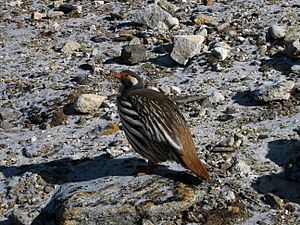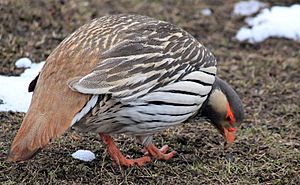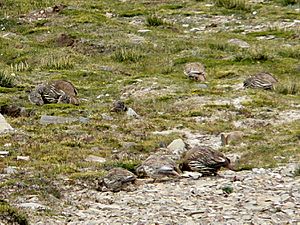Tibetan snowcock facts for kids
Quick facts for kids Tibetan snowcock |
|
|---|---|
 |
|
| Conservation status | |
| Scientific classification | |
| Genus: |
Tetraogallus
|
| Species: |
tibetanus
|
The Tibetan snowcock (Tetraogallus tibetanus) is a type of bird that belongs to the pheasant family. These birds are found in the high mountains of the Western Himalayas and the Tibetan Plateau. They often live in the same areas as the larger Himalayan snowcock. Tibetan snowcocks have a grey head and a white patch behind their eyes. Their belly is white with black stripes. When they fly, you can see a wide white edge on their wing feathers.
Contents
What Does the Tibetan Snowcock Look Like?
The Tibetan snowcock is smaller than the Himalayan snowcock. It has a grey head and neck. There is a white patch behind its eye and above its dark cheek. Its chin, throat, and chest are white. It also has two grey bands on its chest.
Its wing feathers are grey with white edges. The feathers on the back part of its wings have a wide white edge. This white edge looks like a band when the bird is flying. The lower part of its body is white with black stripes on its sides and belly. Its tail is reddish-brown, and the feathers under its tail are black. Both its legs and beak are reddish.
Male and female Tibetan snowcocks look quite similar. However, females have some buff (light yellowish-brown) colors on their head, neck, and chest bands. Males also have small spurs (sharp points) on their legs, which females do not have.
Where Do Tibetan Snowcocks Live?
Tibetan snowcocks live in high mountain areas. You can find them in alpine pastures and rocky ridges above the tree line. Their home range includes the Pamir Mountains in Tajikistan, the Himalayas (from Ladakh to Arunachal Pradesh), Tibet, Pakistan, and China.
During winter, or when there is a lot of snow, they move to lower altitudes. In some places, they live in different areas than the Himalayan snowcock. But in other places, their homes overlap.
The Tibetan snowcock has a very large area where it lives. Its population does not seem to be decreasing. Because of this, the IUCN (a group that studies animal populations) says it is a species of "least concern." This means it is not currently in danger of disappearing.
How Do Tibetan Snowcocks Behave?
Tibetan snowcocks are similar to Himalayan snowcocks. However, they prefer to live at even higher altitudes. In winter, they move down to lower areas. They often travel in small groups called coveys.
When someone approaches them from below on a hill, they usually move higher up. They stop often to look at the person. If they get scared, they fly quickly downwards, often crossing a valley. Their flight is fast, and they often make a whistling sound while flying. They also call out several times when they land. After landing, they shake their tails many times.
These birds call in the morning and evening. They become quiet in the middle of the day. They like to stay on grassy plateaus and ridges. They also live on rocky plains that have very little plant life.
When they are eating, they do not have a bird watching out for danger. But when they are resting in the middle of the day, one or more adult birds will sit on high rocks. They watch for danger and warn the group with loud, long whistles if something is approaching. They make different sounds, including a chuckling sound that gets louder, a whistle, and a call that sounds like a curlew bird.
Reproduction and Life Cycle
During the summer, Tibetan snowcocks form pairs. It is believed that males stay with only one female. Their nest is a simple scrape on the ground. It is lightly lined with material and hidden under a stone or bush. They usually build their nests on the side of a bare hill that is protected from the wind. They avoid areas with a lot of plants.
A female usually lays about 4 to 6 eggs. The male bird stands guard while the female sits on the eggs to keep them warm. Both parent birds stay with their young after they hatch. If the young birds are in danger, the adult birds will try to distract the threat. The chicks will crouch down or hide between stones. Sometimes, young birds from more than one female will form a single group to look for food.
See also
 In Spanish: Perdigallo tibetano para niños
In Spanish: Perdigallo tibetano para niños





